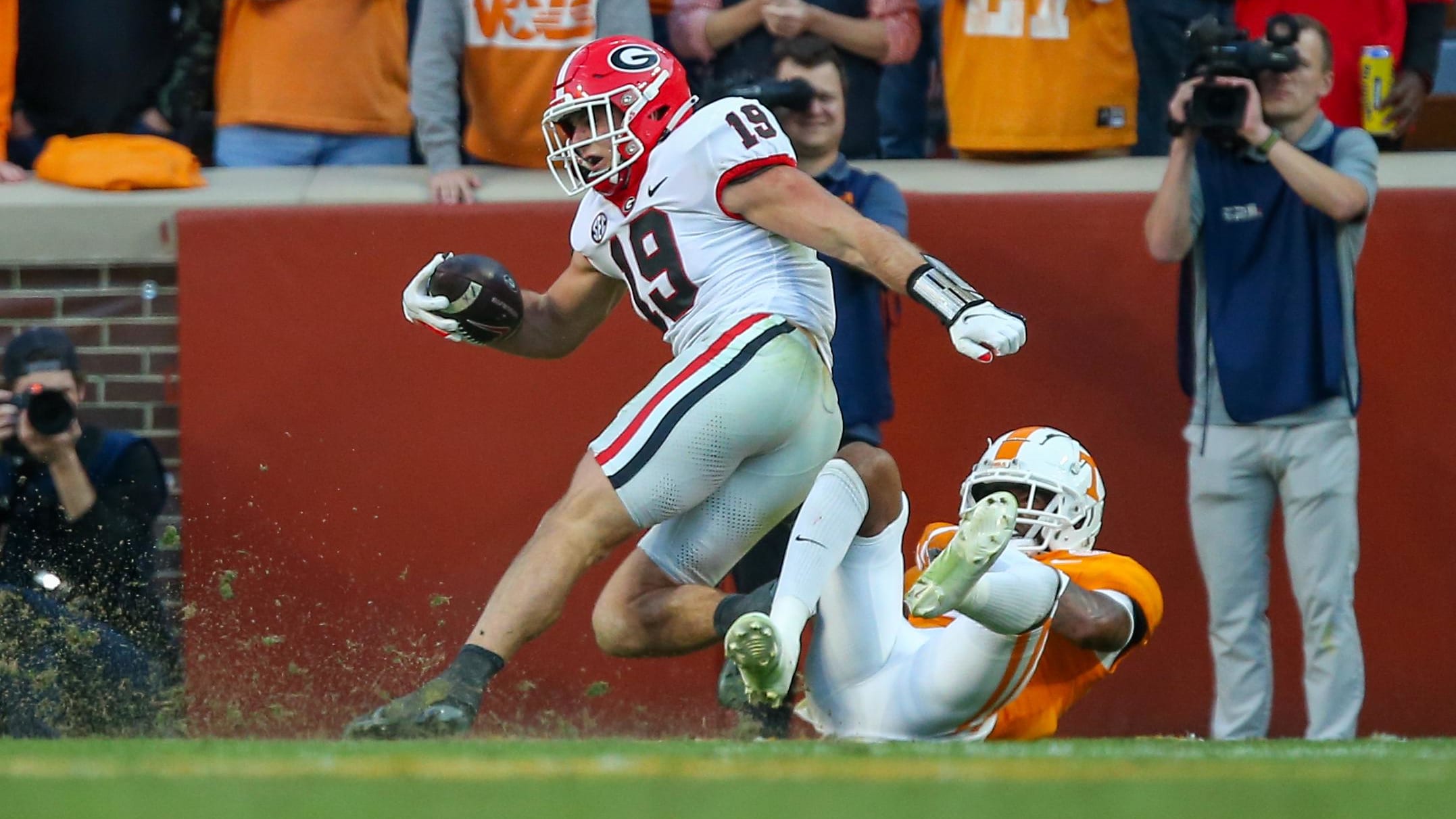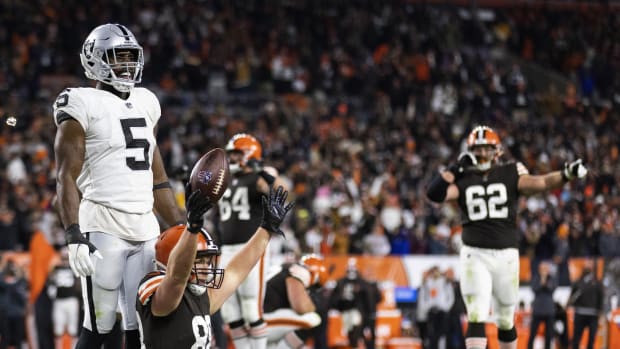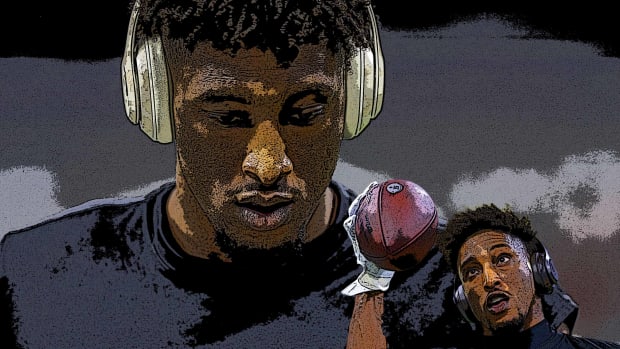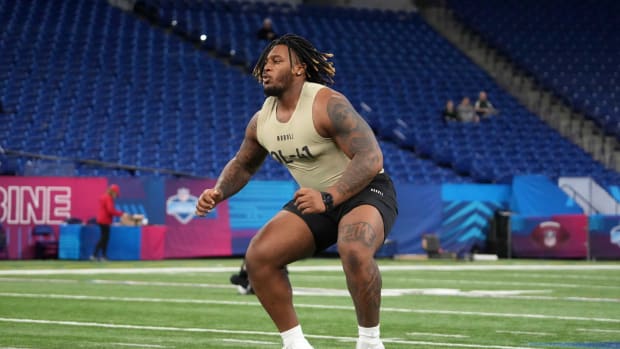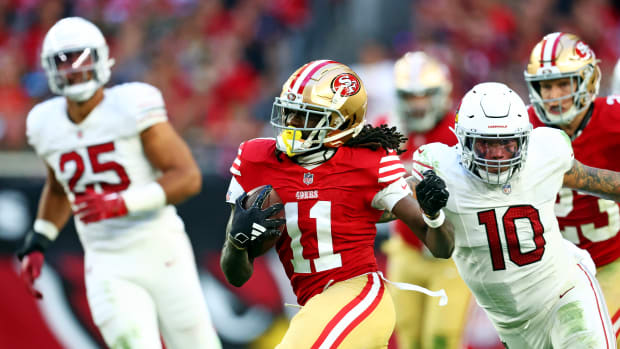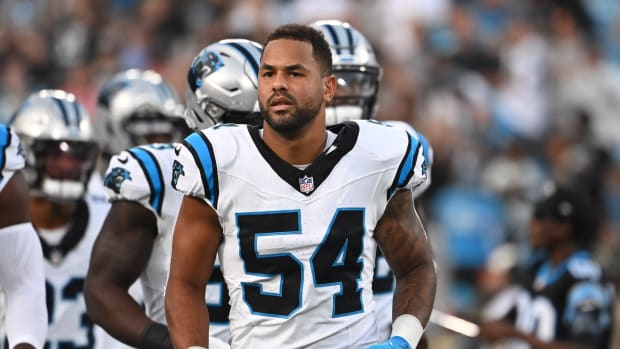NFL Offseason Programs Kick Off, and There Could Be Plenty of Stars Who Skip Workouts
Among the no-shows could be Justin Jefferson, Ja’Marr Chase, Micah Parsons and Patrick Surtain II. Plus, more on franchise tags, Georgia’s pro day, Nick Chubb’s contract and Bill Belichick’s teaching sessions in this week’s takeaways.
The takeaways are coming to you this week from across the pond. We’ll be back stateside on Tuesday, with my ramp-up to the NFL draft coming to you in earnest. Until then …
Offseason programs kick off for 25 teams on Monday, and we’ll see who decides to show and who doesn’t. There are enough brewing contract situations across the league to think that a few guys from the 2020 and ’21 draft classes won’t be with their teams. Minnesota Vikings star Justin Jefferson skipped last year’s offseason program, so it’s hard to imagine he’ll be there this year without an extension. There are a lot of guys from the ’21 class—Ja’Marr Chase, Micah Parsons, Patrick Surtain II—that have a case for getting paid early.
Then, you have the quarterbacks.
I don’t think Tua Tagovailoa, Jordan Love or Dak Prescott are going to skip because it’s harder to do that at their position. But it’s also not going to be easy for their teams to do new contracts, given where the quarterback market has gone over the past year.
A year ago today, if you take out the Aaron Rodgers anomaly contract in Green Bay, no quarterback had made it over the $50-million-per-year threshold. And from there, things quickly changed. The Philadelphia Eagles’ Jalen Hurts got $51 million per year on April 17. The Baltimore Ravens’ Lamar Jackson got $52 million per year on April 27. The Los Angeles Chargers’ Justin Herbert got $52.5 million per year on July 25. And the Cincinnati Bengals’ Joe Burrow got $55 million per year on Sept. 7.
That’s a 13% jump over the $48.5 million per year Russell Wilson signed for in September 2022, and an 8% jump just from Hurts to Burrow over five months.
It also makes, at least on paper, less likely that you’ll see the game of contractual leapfrog that you did a decade ago, when Andrew Luck moved the market in 2016, then Derek Carr leapfrogged him in ’17, only to be jumped by Jimmy Garoppolo in ’18, who was bested by Matthew Stafford later that year, who then was topped by Matt Ryan.
So let’s say, then, the Dolphins, Packers or Cowboys are unwilling to simply go to $56 million per year with their quarterbacks? Then, what? And then, where are the implications for someone such as San Francisco’s Brock Purdy, who could be in the same boat in a year, when he’s eligible for a second contract for the first time?
To be clear, I’m not saying those guys won’t be playing for their respective teams come September. But if there’s a team that surprises and takes a quarterback a little earlier than you might’ve thought, such a decision could be born of this dynamic.
Which, for now at least, is just something for all of you to file away.
On the flip side, there’s been little franchise-tag drama this offseason. Eight guys were franchised in February and early March. Since, Ravens DT Justin Madubuike, Chicago Bears CB Jaylon Johnson, Indianapolis Colts WR Michael Pittman Jr. and, last week, Jacksonville Jaguars OLB Josh Allen have signed top-end deals with their teams. Meanwhile, Brian Burns and L’Jarius Sneed were traded, and the New York Giants and Tennessee Titans paid them. And transition-tagged New England Patriot Kyle Dugger got a deal, too.
That leaves Tampa Bay Buccaneers S Antoine Winfield and Bengals WR Tee Higgins as the only tagged guys who are left unsigned.
This, of course, is a pretty massive departure from what had long been the norm in these situations—where guys would be irate over being tagged, and contract disputes would routinely drag into July, at which point either a deadline-beating deal (the deadline for franchised guys to do long-term deals always falls on July 15 or, if it’s on a weekend, the Monday after) would happen or it wouldn’t.
So what gives? For most of the last 20 years, getting a star player on a franchise tender has been a good deal for a team, which saps said team’s motivation to get a new deal done. Now, that’s not the case. With the rising tag numbers, and more teams pushing bigger cap charges into the future to fit more players in now, clubs are trying to avoid paying the rising lump-sum prices.
Six of the 12 tags now top $20 million. A seventh, cornerback, is over $19 million. Even the safety tag, long affordable for teams, is now over $17 million—which explains why the Patriots dusted off the transition tag for Dugger.
So, the idea of giving guys deals in that neighborhood on an annual basis isn’t crazy anymore, and can even be seen as protecting teams against the cap continuing to shoot up in the years to come. Burns and Allen topping $28 million per year when Nick Bosa is pulling down $34 million per year isn’t so bad. Madubuike’s $24.5 million per year is relatively modest against the Aaron Donald and Chris Jones paydays. And getting Sneed and Johnson under $20 million is taking advantage of a corner market that hasn’t moved in four years.
All of this will make for a quieter return to work for NFL teams in mid-July.
But it’s not like they’re doing it out of the goodness of their hearts.
Georgia’s makeup pro day had a couple of developments worth paying attention to. And these aren’t earth-shattering things. But tight end Brock Bowers and tackle Amarius Mims, who were out there Wednesday after missing the Bulldogs’ larger March 13 pro day with injury, both made decisions that could impact where they land.
Both players chose not to test, and that might wind up biting Bowers, who was such a dangerous athlete at the tight end position that Georgia handed the ball off to him on reverses and end-arounds routinely, and a big play waiting to happen in all situations. The trouble is—at 6’3” and 241 pounds—he doesn’t fit the NFL’s traditional tight end box.
And if you can’t play Bowers in-line, and rely on him to play as a two-way tight end (capable of blocking and producing as a pass catcher), you’ll probably have to make special accommodations in your offense to get the most out of him, and keep him on the field all the time. You’d do that for a freak athlete. Is Bowers one? He looked like it as a collegian. But the NFL is a different setting, and that’s where having verified numbers comes in.
That, to me, makes his case a fascinating one for teams considering him in the top half of the first round. It’s tough to find a comp for him. Shannon Sharpe? Dallas Clark? And it gets harder to make that leap without knowing exactly where he stacks up athletically. Just three tight ends coaches were in attendance for the workout—the New York Jets and Giants were two—and the overall attendance was, for obvious reasons, much lower than what Georgia drew for its traditional pro day a month ago. So a lot of folks haven’t even seen Bowers move in-person.
Then, there’s Mims, whose case is simpler. The wildly talented, former five-star recruit chose not to weigh in at his pro day, even after being prodded by teams, and it’s fair to ask why. Mims only started eight games as a collegian, missing time because of injury, and then pulled out of the combine with an injury. He did come in at 6’8” and 340 pounds in Indy, running a 5.07 40-yard dash. But there’s a lot of projecting going on already, and the fact that he wouldn’t step on a scale probably didn’t help.
Last year, Ohio State’s Dawand Jones refused to weigh in at his pro day and fell to the fourth round. That won’t happen to Mims, but it might cost him a few spots in the first round.
Now, with all of that established, both guys did look good in position drills. Bowers was plenty explosive, with good burst and change of direction, and ran routes and did blocking drills for scouts. Mims, who drew offensive line coaches from five teams (in addition to all of the scouts), showed to be fluid at his size with a lot of power. And though he had moments showing how raw he is (hand placement, etc.), he accepted the coaching he got during the workout.
Even if they slide a little, it’s a fair bet both of these guys are going in the first round.
The Nick Chubb contract adjustment is a fine solution for both sides, and a reflection of how cutthroat the NFL is. The Browns star was going into a contract year as it stood—with an $11.775 million base salary and $425,000 in per-game roster bonuses making up his compensation for 2024.
Chubb can still get to $12.2 million this year, but it’ll be a lot harder to do it.
In this case, the trade-off goes both ways. The Browns get some cap relief, lowering Chubb’s number by nearly $10 million, and financial protection, with Chubb returning from the devastating knee injury he sustained in September. Chubb, in turn, basically assures his roster spot coming off the injury, and some peace of mind amid physical uncertainty.
And, yes, it’s the reality of the business. He’ll also turn 29 in December, so it’s not like some free-agent windfall is coming next year. But that doesn’t mean it doesn’t suck to see it.
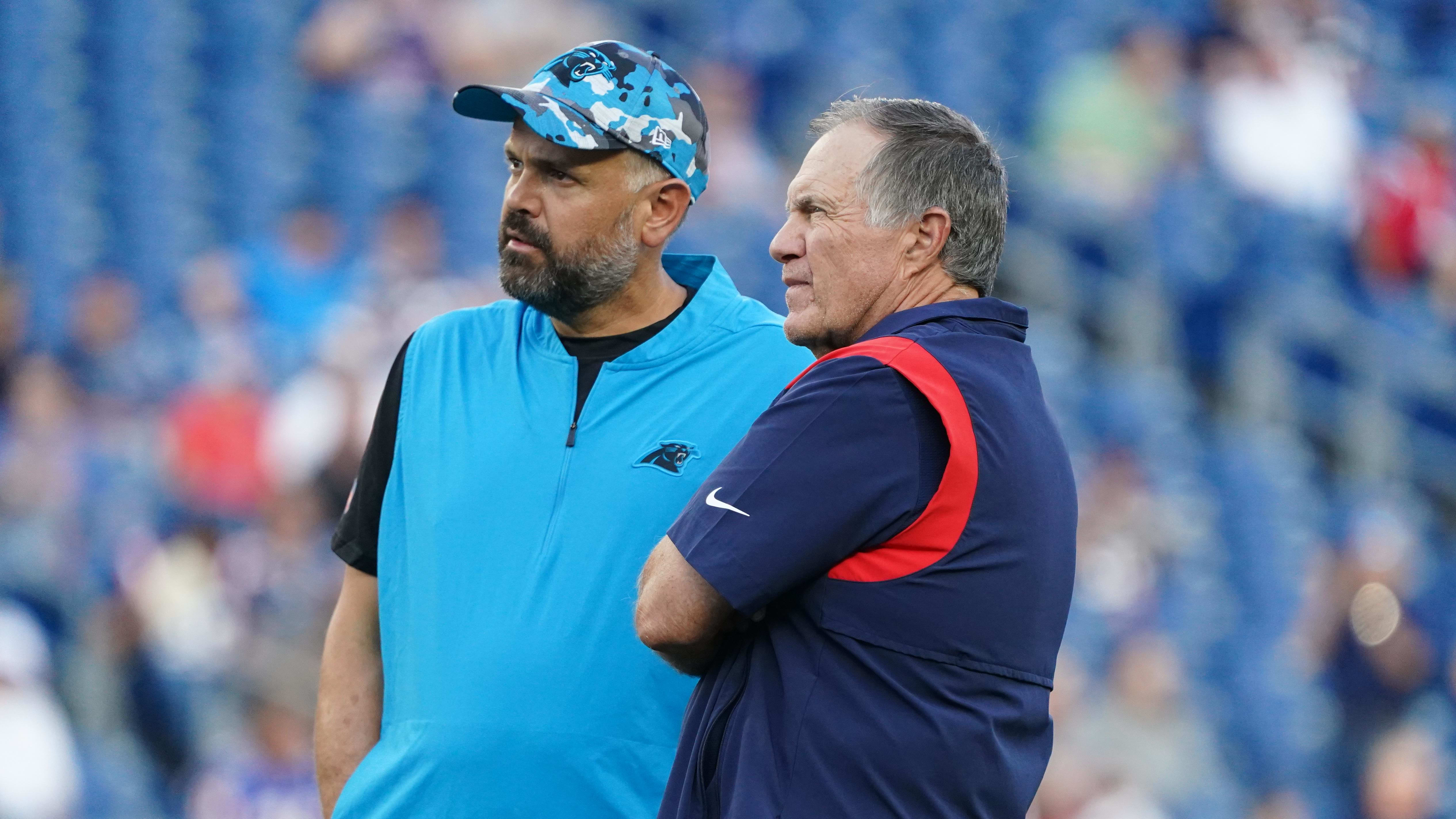
Rhule, who now coaches Nebraska, on Belichick: "He is so smart, has seen so much, that he can make the complex so simple that it humbles you and embarrasses you."
David Butler II-USA TODAY Sports
I don’t know that I expected my Bill Belichick tweet from last week to go viral. My jumping off point was a Matt Rhule press conference during which he detailed a recent Belichick visit to Nebraska.
“He is so smart, has seen so much, that he can make the complex so simple that it humbles you and embarrasses you,” Rhule said. “I was embarrassed yesterday listening to him, how smart he is, how simple it was. … He went four-and-a-half hours just with the coaches, forget the clinic, when he met with our coaching staff. Three-and-a-half hours in, I was like, Coach, would you like a water? A coffee? Would you like to use the restroom? Because I desperately had to use the restroom. And he’s like, I’m fine, Matt. I was like, Yes sir.
“Just sitting there and just talking, his recall for things 15 years ago, and the only reason we don’t get through more information is because he’s having to slow down to make sure you understand what he’s saying. So you have this man who’s a savant, who’s been a defensive coordinator, who’s been a special teams coordinator, he could be an offensive coordinator, he’s been a head coach twice, he’s been the GM, and he’s talking about football in a way that illuminates things, make things so simple that you’re like, Oh my goodness.”
Here, then, was my reaction …
So in what Rhule said, I think there were a couple of things you could take.
First, and most obvious, is that Belichick hasn’t lost his fastball. At his peak, his players would always describe the same sort of scenario Rhule was laying out—Belichick’s ability to teach and coach the complex in such a distilled, simplistic way—was what empowered them to play fast and carry out his plans at the highest level. Oftentimes, Belichick would start a game week with a short list of things to be accomplished, telling his teams if they did those things, they’d win. And he was almost always right, win or lose.
What Rhule illustrated was Belichick doing that for the Nebraska staff.
Second, his passion for the game is still clearly there. He traveled to Nebraska to do this. Right around the same time, he went to Seattle to do the same sort of stuff for his buddy Jedd Fisch’s staff at the University of Washington, where his son Steve works. And this is all in the first three months he’s had without an NFL job since he was in college.
Which brings me to the larger point I was trying to make. He wanted to coach in 2024. He was willing to cede personnel control to do it. He had a staff ready to go. And with seven jobs open (that’s not counting the Patriots job), someone should’ve jumped on the chance to hire him. No, it’s not a sure thing that it works. He wouldn’t have been a fit for everyone. But every hire is a crapshoot, and he should’ve fit for someone. So on what planet is a swing on Belichick not a worthy one to take?
Actually, I can tell you which planet. The one where owners are generally more worried about their own personal comfort, and having fun with the toy they bought themselves than winning. One where big-shot billionaires don’t want to run the risk of feeling like someone else is in charge (which, I think, is also why it took so long for Jim Harbaugh to get a second shot, and why Mike Vrabel is out now), and capable of walking all over everyone.
And what will fix it? A few of those billionaires getting embarrassed in another way—by running losing operations—this fall, and deciding it’s time to prioritize winning.
I really don’t even know what to say about the passing of O.J. Simpson. So maybe the best way to encapsulate why that is to explain what that story was like to live through. To truly get that part of it, you have to know what Simpson was before the deaths of Nicole Brown Simpson and Ronald Goldman to most Americans.
He was NBC’s sideline reporter with a high-wattage smile. He was Nordberg from “The Naked Gun.” He was the guy running through the airport in Hertz commercials.
He was also one of the greatest running backs, and even players, of all-time. With those who played before I was born, I routinely go back to what my dad would say when I was a kid. The Juice, for him, was in rarified air, up there with Jim Brown and Dick Butkus and Gale Sayers and Bobby Layne (he grew up a Lions fan) among the greatest he’d ever seen.
Simpson rushed for 1,000 yards in just seven games twice, which has only been accomplished, again, once. He’s still the only guy to get to 2,000 yards in 14 games, and his average of 143.1 rush yards per game from that 1973 season is still an NFL record. He retired with 11,236 yards, second all-time at the time, behind only Brown.
All of that now, of course, is only a preamble to what he’ll really be remembered for, and that’s the murder trial of 1994 to ’95. The trial made celebrities of judges (Lance Ito), lawyers (Johnnie Cochran, Robert Shapiro and Marcia Clark), and witnesses (Kato Kaelin). It changed the way we deliver and consume news in this country.
And at its center was a pro athlete-turned-broadcaster-actor-pitchman who was beloved in America. The warning signs were there prior, and uncovered later. But that was a time in which we weren’t wasting as much energy gazing into the personal lives of our celebrities. So for most of us, the idea of Simpson as an alleged murderer took time to comprehend—something reflected by the signs posted on freeway overpasses during the Ford Bronco chase.
We all have our opinions on the truth. In fact, most of us have the exact same opinion.
And, really, his enduring legacy centers on what so many of us are convinced he did in the spring of 1994. On a personal level, it changed how I looked at athletes, and celebrities in general. I’d never simply assume that the forward-facing version of such a person was the real person again, and that flows into how I do my job now. I think a lot of people, especially those who, like me, were really young at the time, had a similar experience.
So now that Simpson is dead, it’s hard to feel any emotion over it at all. Other than to hope that, in the three decades since 1994, the Goldman and Brown families have found some peace.

Kraft doesn't want to be picking in the top three of the NFL draft again after a disastrous 2023 season.
Eric Canha-USA TODAY Sports
As much as the New England Patriots have tried to keep everyone guessing, much of their pre-draft work has focused on the three quarterbacks pegged to go in the range they’re picking. New England had North Carolina QB Drake Maye in the week before last. LSU’s Jayden Daniels was in last week. And Michigan’s J.J. McCarthy will visit the Patriots today. Those three are also the three that got a visit from a larger Patriots contingent—around nine guys in each case—at their pro days.
That drills down on three possibilities, and each which would impact the rest of the top 10.
The simplest scenario: The Patriots sit there and take a quarterback at No. 3. I think the 2023 season caught owner Robert Kraft completely by surprise, and I don’t think he wants to be picking in this range again. So I’d bet he views this as a rare chance to get a quarterback at this level, and would like his football people to take advantage of it.
The second scenario is the most complicated. That’d be for the Patriots to trade down and then back up. Cardinals GM Monti Ossenfort, who served over a decade and a half in the Patriots’ scouting department over two stints, is sitting there at No. 4, and could be a partner if New England goes down to, say, No. 11 with the Vikings, then wants to come back up for the fourth quarterback. They could also trade to No. 5 where the Chargers sit if Ossenfort’s price is too high, though that would be risky because it’d allow for someone else to leapfrog them.
The third scenario is the Patriots trade down, and punt on taking a quarterback in the first round. It sounds like there is healthy debate in the building between Maye and McCarthy—as there should be with a good number of voices heard on it. So the Patriots could take 11 and 23, and a 2025 first-rounder from the Vikings, drop down, and address their receiver and tackle needs, and push their quarterback need to next year.
That, to me, seems the least likely, especially since it signifies playing the long game, with an 82-year-old owner who’s not pleased with how the last year has played out. But it also wouldn’t be the wildest idea given that the roster is going to take time to rebuild.
Could a young quarterback accelerate all that? We’ll find out soon enough if the Patriots think so.
The Arizona Cardinals aren’t just going to move to move. The more I’ve talked to people, the more I think Ossenfort, who was aggressive in going down and up the board in his first draft running a team, is considering staying at 4 and picking.
It might be a GM playing poker, and trying to smoke out better offers.
But, it could also be that he really likes the player who’ll be there for him.
What’s unique about Arizona’s position is that, despite picking fourth, the Cardinals will almost certainly have an opportunity to pick the best nonquarterback in this year’s class. What a few people have said to me over the past few months, to that end, is that Ohio State’s Marvin Harrison Jr. would be a wheelhouse pick for Ossenfort, the same way Harrison’s ex-teammate Paris Johnson Jr. was in 2023.
What does that mean? Well, being from the New England system, Ossenfort really does value guys who fit the suit, and fill physical prototypes. Harrison, who Ohio State coaches would tell you has been clocked at around 4.35 in the 40-yard dash at 6’3” and 209 pounds, certainly fits that bill. He also is considered a very high character player, particularly from a work-ethic standpoint, which checks another important box for Ossenfort.
So Ossenfort could sit there and pick him. Or set up for the franchise to have multiple first-round picks again in 2025 with a trade down, or even three first-rounders this year, if they were to swap spots with Minnesota. All of that is in front of the Cardinals.
“We will be ready to pick a player,” Ossenfort told me a few weeks back. “I know that. We’ll have our draft board set and we’ll be ready to pick a player and that’s going to be up to the other teams to decide that there’s a guy that if they want to come up and do a trade. We are. Inevitably, we’ll always be ready to pick when it’s our turn, and we’ll also be ready to listen to any phone calls that come in should there be interest in coming up on our pick.”
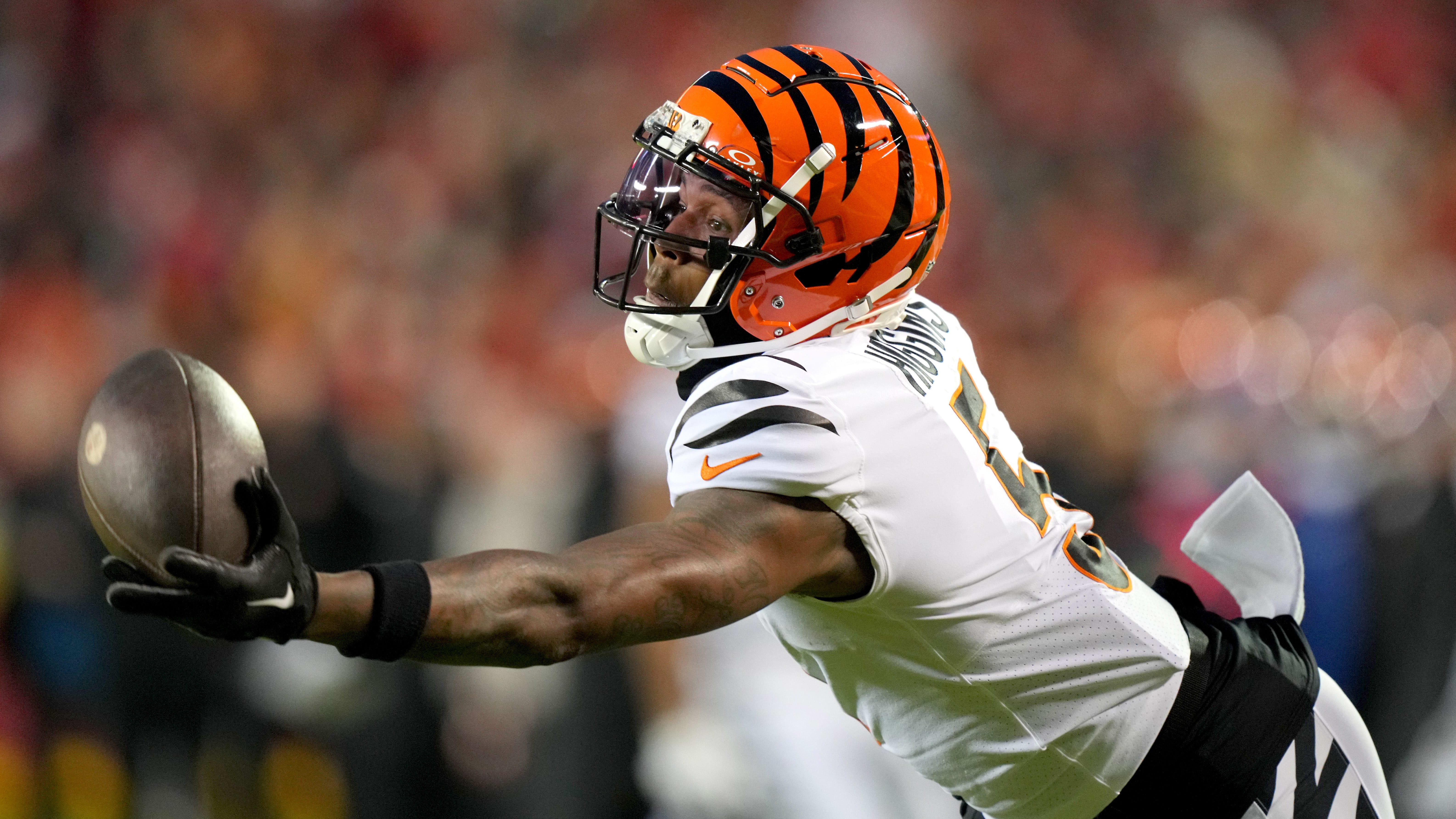
A deep receiver draft could impact whether Higgins is traded by the Bengals.
Kareem Elgazzar/The Enquirer / USA TODAY
The trade markets for Tee Higgins and Brandon Aiyuk should develop further over the coming days. Teams are deep in their draft meetings now. They’ve got a better idea, overall, of how things might play out next week, and where their needs can be met.
One thing that keeps coming up—just how good the receiver group is.
That’s why, as I see it, it’s iffy whether the Cincinnati Bengals and San Fransisco 49ers get offers that motivate them to move their star receivers, even with both teams having so many other mouths to feed on offense. Landing Higgins or Aiyuk, if you’re another team, would presumably cost at least a second-rounder, plus a massive contract, and in a year when guys such as Xavier Worthy, Ladd McConkey, Ricky Pearsall, Keon Coleman and Troy Franklin could be sitting there on Day 2, long after Harrison, Malik Nabers and Rome Odunze are drafted.
That, of course, isn’t to say all those guys will be what Higgins and Aiyuk have become. It’s just that those players will be available at a fraction of the financial cost, and in an era where receivers do seem to grow on trees. And if you can’t get a second-rounder for Higgins or Aiyuk, for contenders like Cincinnati and San Francisco, then it probably makes more sense just to go for a ring with those guys this year, maybe let them go in 2025, and take the compensatory third-rounder in ’26.
That, of course, assumes those teams can’t find a way to pay those guys.
Again, with all those mouths to feed, it’s just tricky.
We’ve got 10 days to the draft. And your quick-hitting takeaways now …
• It’s great seeing a reflective Jared Goff say the “greatest thing” to happen to him was being traded from the Rams to the Lions. In the days to follow the Matthew Stafford deal, Goff’s inclusion was routinely discussed as the salary dump element of the deal. Brad Holmes and Dan Campbell swore Goff was more than that to them. They stuck to their word. And Goff has delivered for them. Just a really good story all the way around.
• I just can’t get Sean Payton’s near-miss on Patrick Mahomes out of my head. Payton loved Mahomes in 2017. The New Orleans Saints were going to take him at 11. And Payton’s old buddy Andy Reid wound up jumping over him to steal Mahomes. I know that’s stuck with Payton. Would it motivate an aggressive move up by Denver? I’m not sure Payton loves any of these quarterbacks like that. But if he does, then … yes.
• While we’re there, there is an assumption floating around in the league that if Bo Nix has any shot to go in the first round, it’d be Payton taking him, because stylistically Nix fits Payton in a Drew Brees, point-guard-on-grass kind of way. Still, selecting Nix with the 12th pick would be high for Nix based on how most others in the league see him. And Denver doesn’t have a second-round pick.
• I love the idea of Tom Brady coming back late in the year, if an injury opens something up on a contender. I also think in the right scenario, he’d legitimately be tempted. One factor in my belief on that: Brady’s retirement last year at 45 didn’t have anything to do with the legendary quarterback thinking he couldn’t physically play anymore.
• Iowa CB Cooper DeJean really helped himself last week, affirming the feeling among NFL teams that he had freakish athletic ability. DeJean could legitimately play just about any spot in the secondary as a collegian, and running in the low 4.4s helped bolster the idea that his versatility will carry over in the NFL.
• One talking point in the NFL the past couple of weeks: Is it possible we could have a top 10 without a defensive player? Yes. You could easily have four quarterbacks, the three receivers, Bowers, and tackles Joe Alt and Olu Fashanu. I don’t know if it’s likely, but it’s possible. My guess, for now, would be that Alabama edge rusher Dallas Turner winds up being the only defensive player drafted in the top 10.
• For what it’s worth, at 10, I’m thinking that Jets GM Joe Douglas does the rational thing, and takes a tackle to give Aaron Rodgers another layer of protection up front, giving the franchise a future past 33-year-old acquisitions Tyron Smith and Morgan Moses at the position.
• Combine medical rechecks were in Indianapolis last week, and Texas RB Jonathan Brooks was one guy to come out with positive reviews. Brooks tore his ACL in November, and the doctors there said that everything looks like it’s on track, and doctors from the teams attending, based on the information they had, didn’t have any extra questions on the knee. Brooks is hoping to be cleared around July 1, which would be a little less than nine months post-op.
• When Bill Callahan develops an offensive lineman, and then goes to a new team, and that new team trades for that offensive lineman, I’m paying attention. And so you should probably keep an eye on tackle Leroy Watson—dealt from Cleveland to Tennessee last week—too.
• Is there a way to gamble on a certain player (Blake Corum) being drafted by a certain team (the Chargers) on Day 2?

































